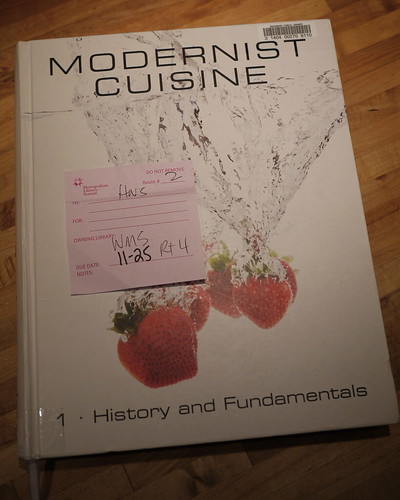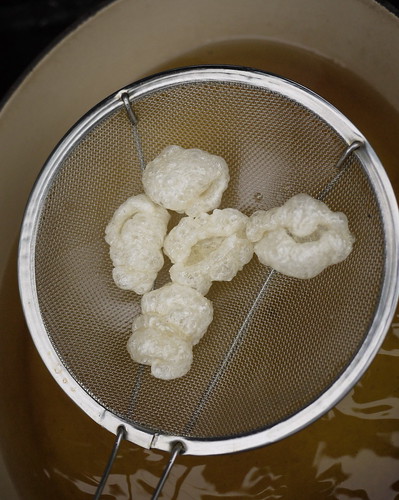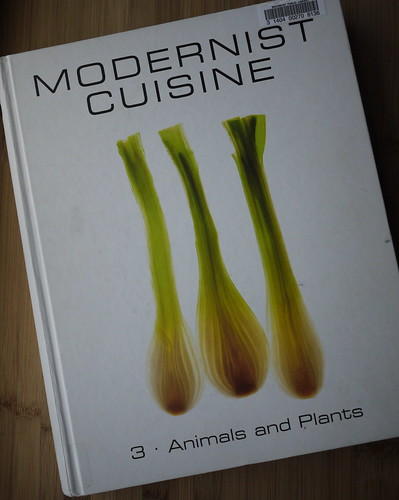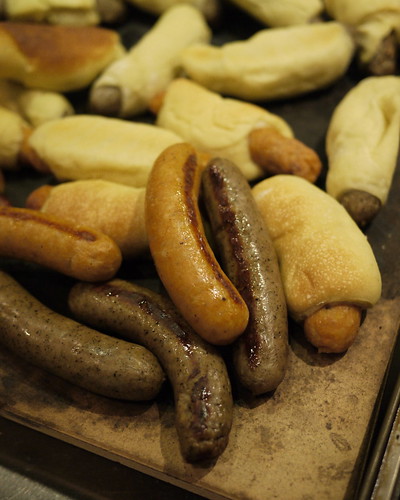
In this episode, Sausage and Modernist Cuisine.
A good cookbook inspires you to cook. Even if the book is loaded with recipes that require expensive equipment or use hard to find ingredients, if it sets your brain a percolating, then it's worth it. Ok EVEN IF the recipes don't inspire, and the galactic reams of scientific jargon make your brain numb, if you glean a small nugget of information that improves your cooking, then it's worth borrowing from the library.

Over the past month I have been receiving various volumes of Modernist Cuisine, by Nathan Myhrvold, Chris Young, Maxime Bilet and Ryan Matthew Smith. I requested them from the library. So far I have gone over (in the order that they were received) Volumes 1, 4, 5 and 3. I laughed, I cried, it's was better that Cats.
I read Volume 1 just about cover to cover (I couldn't stay awake for chapters 5 and 6). I found the the history tracing the "Modernist Movement" and the chef profiles very interesting. I immediately searched out books by Keller, Blumenthal, Ferran and Achatz.
However the surveys of cooking history , microbiology for cooks, food safety, and Nutrition (called "Food and Health" in the book) were well trodden and bland. Anyone who has been to culinary school and/or read the New York Times would find themselves in familiar fields. Albeit in some parts these vast fields are described down to the single blade of grass. So who is this book for? It's pedantic for the trained cook, and tediously technical for the novice. I contend it's for no one, except for the writers. Volume 1 is subtitled "History and Fundamentals," and in it Myhrvold and his crew lay a base of general cookery engineered to support the thesis that Modernist Cuisine movement will/has revoulutionize(d) how people cook and think about cooking. I think it has changed the face of fine dining, but we are a long way off from seeing mini science lab set-ups as part of the home kitchen routine. Nonetheless these volumes are worth a gander.

Other volumes varied from "Ooo that sounds interesting" to "Oh, we were doing that at work."

For instance a few months back I decribed a method for making chicharones at home. It's boil, dehydrate and fry. In volume 4 page 302, there's a table of "Puffed snacks." Chicharones are not specifically on it but the process is.

Volume 3 is pretty cool, especially the chapter on sausage, titled "Restructuring." Again a lot of the information shared here can be found in other places, but the tables listing industrial additives are informative. Not that I will ever get my hands on any of this stuff. One product I have worked with is Activa. Yogurt you say? No, meat glue. At the restaurant we used it to glue together pork shoulder roasts that we were curing as hams. You can read the book for a more scientific description, but suffice to say Activa replicates naturally occurring enzymes that binds proteins together. We would form our roasts, sprinkle on the powdered glue and roll them tightly in plastic. The next day we would have solid boneless footballs ready to smoke.

Sausage making is all about binding meats, or was Myhrvold calls it in a most Mary Shelley way, Restructuring. Forming a good emulsion (that's binding)is something with which I am always tinkering, and this book explained a couple of key concepts that for me, resulted in very nicely textured sausage.
Pre-salting. Somewhere in the sausage chapter Myhrvold mentions salt on meat draws out the enzymes that bind proteins together, and that salting the cut up but not ground meat helps the prepare for the bonding activity. Seasoning before grinding is a concept I first read in Ruhlman's Charcuterie, and I did it for a while, but when I would want to make different sausages (ie Sausage Mania)I found that adding the seasonings later meant that I could do all my grinding at once, and it didn't taste all that different to me. But pre-salting for binding, I would have to try that. I salted the cut up meats, (in this case duck and chicken) and let it sit for 24 hours.
Water. Some of the Modernist Cuisine sausage formulas call for 10% added water. In their book Home production of quality meats and sausages, Stanley Marianski and Adam Mariański describe the water absorbtion values of lean meats. Also most of the sausage recipes in Charcuterie, call for the addition of liquid. My point here is that "Modernist Cuisine" puts forward information that has been previuously published, however it is nice to see the information in a table, and the easy to remember percentage sticks in my brain.

I made two sausages for a party recently, A Chicken and pork hot link,

and a coffee and lavender duck sausage. Using the two tips from the sausage chapter, I ended up with some beautiful sausages. I'll write more about these specific sausages in the coming weeks.
To conclude, I heartily suggest you check out these books from the library, they provide a glimpse to what is in evolving in commercial kitchens today. I haven't received Volume 2, Techniques and Equipment, really the meat of the matter in Myhrvold's quest. The overall idea you should take away from these volumes that cooking with precision makes tastier food, and now with instant read thermometers, and better cooking tools, it's become easier to cook with precision. In short, don't overcook the sausage!

Cheers.
19 December, 2011
Thanks Nate.
14 December, 2011
Curing a Ham for Chirstmas Part 2

Sorry it's been a little more than a week since we last talked. The ham came out of the brine last Thursday and it's been hanging in the fridge. I'll let it go a few more days, then I'll put it on to smoke.
Subscribe to:
Posts (Atom)

